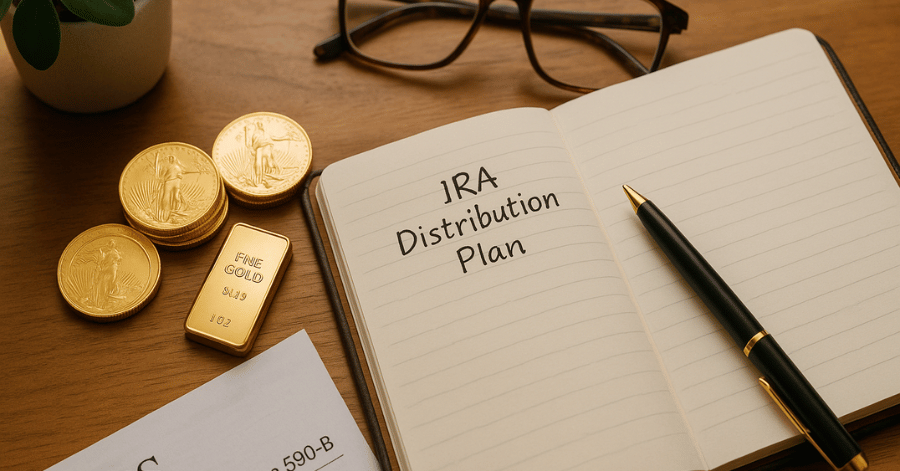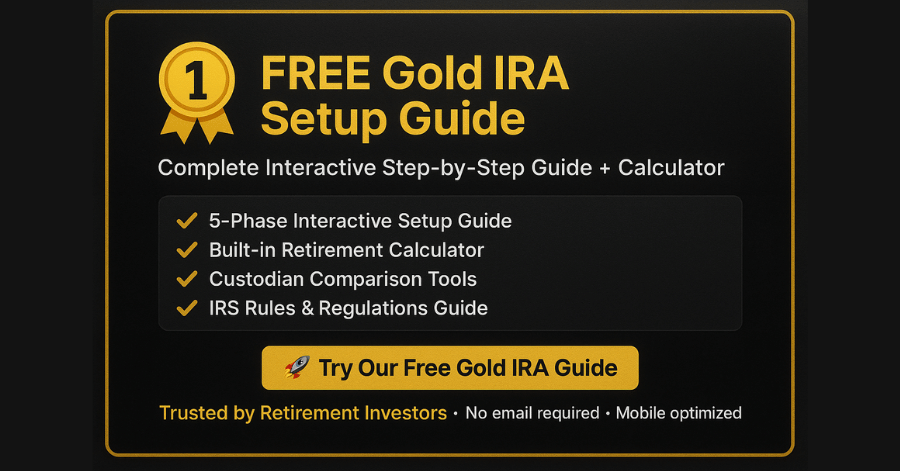Read our Gold IRAs and Retirement Planning

Secure Your Golden Years or Navigate a Minefield?
Funding your Gold IRA Account is a crucial next step. This comes after you decide to add precious metals to your retirement plan. Indeed, setting up a Gold IRA is a major decision. However, moving your funds correctly is vital. This particular stage requires careful attention. Otherwise, your gold-backed future could become a complex rule headache. Many investors often ask: How do I best go about funding my Gold IRA account? Also, how can I ensure compliance and gain maximum benefits? This guide will light the way forward.
Your journey to a gold-backed retirement does not stop at choosing a custodian. It truly picks up speed when you decide how to move money. Understanding options for funding your Gold IRA account is very important. This knowledge can mean a smooth, tax-efficient shift. Conversely, a lack of it can cause costly mistakes with penalties. Ultimately, this process is not just about fund transfers. Instead, it’s about strategically placing your assets. This helps build a more secure financial future.

Core Analysis: The Mechanics of Gold IRA Funding
Successfully funding your Gold IRA account hinges on understanding the approved methods and their specific requirements. Each path of financing your Gold IRA account has its own set of rules and implications.
Section 1: The Gold IRA Funding Blueprint: Transfers, Rollovers, and Contributions
There are primarily three ways for funding your Gold IRA account: direct transfers, rollovers, and new contributions. Each method serves different needs and comes with its own set of procedures.
Direct Transfers:
- The Seamless Shift: A direct transfer is often the simplest and safest way to fund your Gold IRA. Your current IRA custodian sends funds directly to the new Gold IRA custodian. The account holder never takes possession of the money.
- How it Works: Usually, you fill out a transfer request form. Your Gold IRA custodian provides this. Then, they work with your old custodian to move funds.
- Advantages: The primary advantage is the elimination of tax consequences and penalties. Since money moves directly between custodians, the IRS sees no distribution. “A direct trustee-to-trustee transfer is the simplest and most foolproof way to move IRA assets,” notes an IRS guide on retirement plan rollovers (referencing general IRS guidance on IRA transfers).
- Data-Driven Example: According to IRS rules, there’s no limit to how many direct transfers you can make annually between IRAs.
Rollovers:
- Navigating the 60-Day Rule: A rollover involves taking funds from an existing retirement account. This could be a 401(k) or another IRA. Afterward, you deposit these funds into your Gold IRA.
- Types:
- Traditional IRA to Gold IRA: Usually straightforward.
- Roth IRA to Gold IRA: Possible, but the Gold IRA would typically need to be a Roth Gold IRA to maintain tax-free growth.
- 401(k), 403(b), TSP Rollover: Common when changing jobs or retiring. You receive the funds (minus any mandatory withholding) and have 60 days to deposit them into the Gold IRA.
- The 60-Day Rule & IRS Compliance: This is crucial. If you take possession of the funds, you have exactly 60 days from the date you receive them to redeposit them into another qualified retirement account. Missing this deadline can result in the entire amount being treated as a taxable distribution, plus a potential 10% early withdrawal penalty if you’re under 59 ½. The IRS is very strict about this rule. “The 60-day rollover rule is a critical deadline. Missing it can be a costly mistake for taxpayers,” warns many financial advisors.
- Tax Implications: If done correctly, a rollover preserves the tax-deferred (or tax-free for Roth) status of your retirement funds. However, if rolling over from a pre-tax account like a 401(k) or Traditional IRA, your employer plan might withhold 20% for taxes. You’d then need to make up that 20% from other sources when depositing into the Gold IRA to roll over the full amount and later claim the withheld amount on your tax return.
- Types:
New Contributions:
- Building Your Nest Egg Annually You can also fund your Gold IRA by making new contributions each year, subject to IRS limits.
- Annual IRS Contribution Limits: For 2024, the maximum IRA contribution is $7,000, or $8,000 if you are age 50 or older (according to IRS.gov). These limits can change, so it’s vital to check the current year’s figures on the IRS website. For 2025, the limit increases to $7,500, with an additional $1,000 catch-up for those 50 and older.
- Eligibility: You (or your spouse if filing jointly) must have earned income. There are also income limitations if you or your spouse are covered by a retirement plan at work and want to deduct contributions to a traditional IRA.
Underrated Technical Hurdle: The Nuances of Custodian Communication and Paperwork. The rules for transfers and rollovers might seem clear. However, a significant hurdle is often underestimated. This hurdle is the administrative efficiency and communication between your old and new custodians. Delays in processing paperwork, miscommunication, or lost forms can jeopardize timelines, especially for the 60-day rollover. As one industry expert from a precious metals dealer put it. “Choosing a responsive and experienced Gold IRA custodian is half the battle“. They must efficiently manage paperwork. They also need to liaise well with your existing plan administrator. This approach can prevent significant headaches and potential tax penalties.
This detailed understanding of funding methods smoothly transitions us to the practical steps involved.
Check Out Our FREE Gold IRA Setup Guide

Now that you’re familiar with the ‘what’ and ‘why,’ let’s delve into the ‘how’ of initiating this crucial process.
Section 2: Funding Your Gold IRA Account: Initiating the Funding Process: A Step-by-Step Approach
Starting the funding process requires careful coordination with your chosen Gold IRA custodian. They are your primary partner in navigating the paperwork and ensuring compliance.
Working with Your Custodian:
- Your Gold IRA custodian is more than just a holder of your precious metals; they are your guide through the funding maze.
- Assistance with Paperwork: A good custodian will provide all necessary forms for transfers or rollovers and often pre-fill some information for you. They should clearly explain each step.
- Required Documentation: This typically includes a signed transfer/rollover request form, a copy of your driver’s license or other government-issued ID, and possibly a recent statement from your existing retirement account.
Step-by-Step Process:
- Decide on the Funding Method: Based on your current retirement account type and financial situation, choose between a direct transfer, rollover, or new contribution.
- Notify Your Current Plan Administrator (for Rollovers/Transfers): Inform them of your intent to move funds. They will have their own procedures and paperwork.
- Complete Custodian Paperwork: Fill out all forms provided by your Gold IRA custodian accurately and completely. Mistakes here can cause delays.
- Monitor the Transfer/Rollover Progress: Stay in touch with both your old and new custodians. For rollovers where you receive a check, remember the 60-day clock starts ticking the moment you receive the funds.
- Confirm Funds are Received: Once the funds arrive in your Gold IRA, your custodian will notify you. You are then ready for the next step: selecting your precious metals.
The Incumbent’s Weaknesses:
Pitfalls of Non-Compliance in Funding The “existing system” here is the set of IRS regulations governing retirement accounts. Its “weaknesses,” from an investor’s perspective, lie in its rigidity and the severe penalties for non-compliance.
- Case Study 1: The Missed 60-Day Rollover Deadline: John decided to roll over $50,000 from his 401(k) to a Gold IRA. He received the check but got busy and deposited it on the 65th day. The IRS deemed the entire $50,000 a taxable distribution. If John was in a 24% federal tax bracket, that’s $12,000 in federal taxes, plus state taxes. If he was under 59 ½, he’d also face a 10% penalty ($5,000). This oversight could cost him over $17,000. (Illustrative example based on IRS rules).
- Case Study 2: Prohibited Transactions: Attempting to fund your IRA with personal gold holdings you already possess directly, without going through proper channels, is a prohibited transaction. This can lead to the IRA being disqualified. The Self-Directed IRA Handbook by Mat Sorensen, a leading expert in self-directed IRAs, often details such pitfalls.
Understanding these potential pitfalls emphasizes the need for diligence when funding your Gold IRA account. This leads us to consider the inherent complexities involved.

For More Information Click Here
While the benefits of a Gold IRA are attractive, it’s important to acknowledge the complexities involved, especially when navigating the strict IRS rules.
Section 3: The Gold IRA Funding Dilemma: Complexity vs. Security
The primary dilemma for many investors is balancing the desire for the perceived security and inflation-hedging properties of gold with the procedural complexities and strict regulatory environment of Gold IRAs.
- Internal Contradictions:
- Desire for Control vs. Custodial Requirements: Investors seeking gold for a sense of direct control over a tangible asset find that IRA rules necessitate a third-party custodian and approved storage depositories. You can’t just keep the gold in your home safe.
- Tax Advantages vs. Regulatory Burdens: The significant tax benefits of an IRA are counterbalanced by the need for meticulous adherence to IRS rules. A simple mistake in the funding process can negate these benefits. “The tax advantages of IRAs are substantial, but they come with the responsibility of strict compliance,” often state tax professionals.
Historical Precedents & Common Challenges:
- Gold IRA funding demands careful navigation of new rules for many investors. This is like the initial rollout of other complex financial products. Consider the early days of 401(k) plans. Or recall the Eurozone’s integration challenges. These required member states to align diverse fiscal policies.
- The challenge isn’t unique to gold. Any specialized retirement account option presents a learning curve. For example, self-directed real estate IRAs share this. Processes must be followed precisely, or errors can occur.
- The common thread is complexity. If unmanaged, this complexity can lead to frustration. It can also cause financial detriment, especially without diligence or professional guidance.
- Similar challenges appear across various investment vehicles. These issues often arise when proper due diligence is skipped. This can happen in emerging markets, like those in Africa or Asia, where regulatory clarity may be an issue. It’s also seen in established markets dealing with complex derivatives. The principle remains: understand the rules of the game before you play.
This complexity prompts some to consider alternatives, which we’ll explore next.
Given the rules and regulations, what if you’re considering other ways to invest in gold?
Section 4: Parallel Systems Rising: Buying Gold Bullion Outside an IRA
While a Gold IRA offers tax advantages, some investors opt for direct ownership of gold bullion outside of a retirement account. It’s important to understand this alternative.
- Direct Purchase of Gold Bullion: This involves buying physical gold coins or bars from a dealer and taking personal possession or arranging private storage.
- Advantages:
- Direct Control & Accessibility: You can hold your gold, store it where you wish (though this comes with security risks and insurance costs), and sell it more readily without IRA distribution rules.
- Simplicity of Purchase: Fewer forms and regulatory steps than setting up and funding an IRA.
- Disadvantages:
- No Tax Advantages: Gains are subject to capital gains tax (collectibles are taxed at a higher rate, up to 28%, according to current U.S. tax law).
- Storage & Security Costs: Securely storing valuable physical gold can be expensive (e.g., bank safe deposit boxes, high-security home safes, or private vaulting services). The World Gold Council often publishes reports discussing the total cost of gold ownership, which includes these factors.
- Insurance: You’ll likely need to insure your holdings.
- Adoption Metrics: While specific “user growth” for direct bullion purchase is hard to track like a digital service, demand for gold bullion often spikes during economic uncertainty. For instance, the World Gold Council reported significant increases in gold bar and coin investment during the 2008 financial crisis and the COVID-19 pandemic, indicating a strong preference for tangible assets in turbulent times. Jewelry, while a form of gold ownership, is generally considered distinct from investment-grade bullion due to markups and differing market drivers, though cultural buying in regions like India and China remains consistently high.
- Advantages:
Understanding these alternatives helps solidify the decision-making process for or against a Gold IRA structure.
Looking ahead, what do financial authorities project, and how can you act on this information?
Forecasts & Actionable Insights to Consider When Funding Your Gold IRA Account
While no one can predict the future with certainty, insights from credible institutions can help shape your strategy.
Long-Term Projections & Perspectives:
- Importance of Diversification (General Retirement Advice): Institutions like Vanguard and Fidelity consistently emphasize portfolio diversification for long-term retirement security. While they might not specifically endorse gold over other assets, their research supports spreading risk. “A diversified portfolio is crucial for weathering market volatility over the long term,” is a common refrain in their investor education materials.
- Central Bank Gold Demand: Central banks globally have been net buyers of gold for over a decade. A 2023 World Gold Council survey indicated that 24% of central banks intended to increase their gold reserves in the next 12 months, citing concerns about inflation and geopolitical instability. This signals a continued belief in gold as a store of value at an institutional level.
- Retirement Savings Gap: Many reports, including those from the Employee Benefit Research Institute (EBRI), highlight a significant retirement savings gap for many Americans. This underscores the need for diligent saving and strategic investment in tax-advantaged accounts like IRAs. The EBRI’s Retirement Security Projection Model® often provides sobering data on retirement readiness.
Investor/Business/Policy Recommendations:
- Thoroughly Vet Custodians: Don’t just pick the first Gold IRA company you see. Investigate their fees, storage options, buy-back policies, and customer reviews. Check their standing with the Better Business Bureau and regulatory bodies.
- Understand ALL Fees: Ask for a complete fee schedule – setup fees, annual administrative fees, storage fees, transaction fees. These can impact your returns.
- Consult a Qualified Financial Advisor: Before making any significant changes to your retirement strategy, especially one involving specialized assets like gold, speak with a fee-only financial advisor who understands precious metals IRAs and your overall financial picture. They can help you determine if a Gold IRA, and how much to allocate, aligns with your risk tolerance and retirement goals. A common piece of advice is not to put all your eggs in one basket; consider how gold fits into a balanced portfolio, rather than, for example, arbitrarily shifting “20% of portfolios to gold” without holistic consideration.
These insights should guide your approach to this significant financial decision.
Conclusion:
Funding Your Gold IRA Account Diligence is Golden
Funding your Gold IRA is more than a transaction
It’s a critical step in securing your financial future with precious metals. While the path can seem laden with complex rules and potential pitfalls – from navigating direct transfers and the strict 60-day rollover rule to understanding annual contribution limits – the process is manageable with diligence and the right support.
The allure of gold as a safe haven
Don’t let gold’s appeal overshadow the need for careful planning and IRS adherence. A Gold IRA diversifies your retirement by adding a unique, potentially stabilizing asset. The key is an informed approach: partner with trusted custodians and advisors to ensure a successful journey into gold-backed savings.
Frequently Asked Questions (FAQs)
About funding your Gold IRA account:
- Q1: Can I fund a Gold IRA with cash from my bank account?
- A: Yes, this is considered a new contribution and is subject to annual IRS contribution limits (e.g., $7,000 for 2024, or $8,000 if age 50+, increasing to $7,500 and $8,500 respectively for 2025). You must have eligible compensation (earned income) to make contributions.
- Q2: What are the tax consequences of a Gold IRA rollover if done incorrectly?
- A: If you miss the 60-day deadline for a rollover, or if the funds are not redeposited correctly, the withdrawn amount may be considered a taxable distribution. You would owe income tax on the amount, and if you are under age 59 ½, you could also face a 10% early withdrawal penalty from the IRS.
- Q3: How long does the funding process for a Gold IRA typically take?
- A: This varies. A direct transfer between custodians might take 1-2 weeks, sometimes longer, depending on the efficiency of both institutions. A rollover, especially from a 401(k), can take longer, from a few weeks to over a month, for the initial distribution to be processed by your employer’s plan administrator. Once you receive the funds (if doing an indirect rollover), you then have 60 days to deposit them.
- Q4: Do I need a new SDIRA custodian if I already have a Self-Directed IRA for other assets?
- A: Not necessarily. If your current SDIRA custodian permits holding precious metals and has relationships with approved depositories, you might be able to use them. However, many Gold IRA companies specialize in precious metals and have established processes and relationships that might be more streamlined. It’s best to check with your current SDIRA custodian about their capabilities and fees for holding physical gold.
- Q5: What are “IRS-approved” gold products for a Gold IRA?
- A: The IRS requires gold coins and bars to meet specific fineness standards to be eligible for an IRA. For gold, this generally means a minimum fineness of .995 (99.5% pure). Examples include American Gold Eagle coins (though the 22k coin is an exception allowed by law), Canadian Gold Maple Leaf coins, and various gold bars from accredited refiners. Your Gold IRA custodian will provide a list of eligible products.







2 Comments